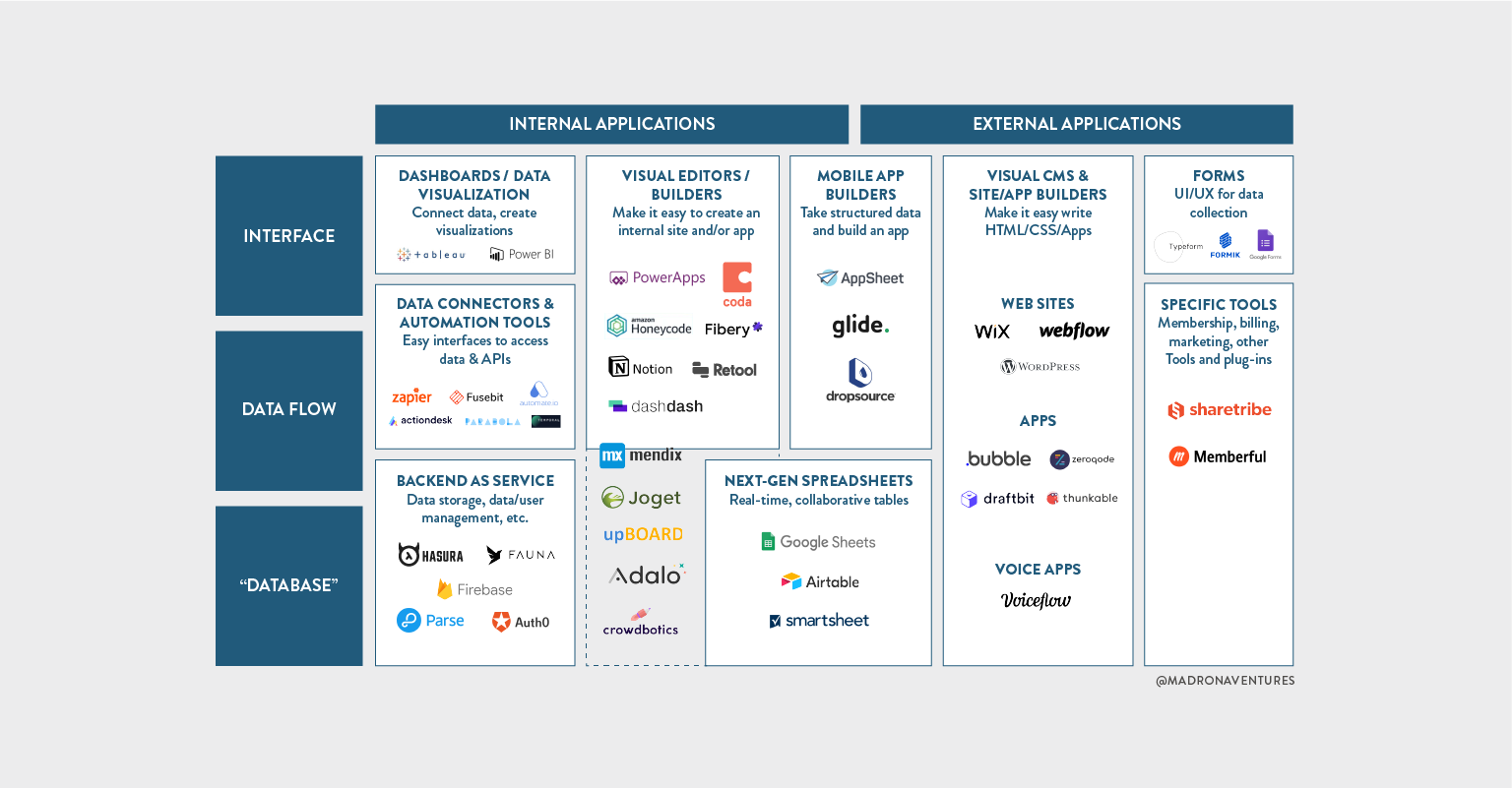Low-code no-code solutions are not new – they have existed in some way, shape, or form for more than thirty years. Microsoft Excel was probably the earliest LCNC solution of its kind — it enabled workflows in various ways for billions of people, most of which are still using it. As a developer, I remember my world changing when Microsoft released Visual Basic. Its graphical user interface (GUI) allowed developers to modify code by simply dragging and dropping objects and defining their behavior and appearance through the creation of an abstraction layer that hid complexities and automated routine tasks.
The idea of creating high-quality solutions at speed and scale without deep coding capabilities or an expensive development team is what most businesses want. Momentum around these Low-Code No-Code solutions started ramping up in the early 2000s with companies like Smartsheet, which focuses on breaking down silos and creating a dynamic work environment. But that momentum has begun to increase significantly over the last decade and even more so in the last five years. We saw the launch of AirTable for workflows, Coda for in-doc collaboration, Microsoft Power Apps and Appsheet, which was acquired by Google, for creating apps, Unqork with its visual development platform, and Plus Docs for real-time data capture and sharing. All of this has the singular focus of democratizing technology to empower creators and builders in the modern world.
Low-code no-code is a visual and hassle-free approach to software development. Low-code no-dode democratizes software application development. Users without deep programming knowledge are able to build enterprise-level applications that are deployable to teams and across enterprises.
In 2020, we published a post on investing in low-code no-code solutions, and early this spring, at our annual meeting, we had the opportunity to bring together three of our portfolio companies that are actively innovating in this space to dive deeper into these solutions and the current and future state of the market. In 2020, we concluded that low-code no-code was an important feature for all enterprise-related applications to integrate. Today, we are updating that to say low-code no-code is becoming the norm, accelerating faster and into more horizontal and vertical environments than we expected back in early 2020. The reasons for this are several-fold – a combination of technological advances, a developer shortage and societal changes brought on by the pandemic. And it’s an area that is open for investment: The current market size (or TAM) is estimated to be somewhere around $12 billion today, growing to over $150 billion in 2030 at approximately a 30% compound annual growth rate.
Defining Low-Code No-Code
In its simplest construct, you can think of low-code no-code as a visual and hassle-free approach to software development. Low-code no-code platforms abstract, automate and optimize every step of a process and enable rapid delivery of any software solution. Low-code no-code democratizes software application development – users without deep programming knowledge are able to build enterprise-level applications that are deployable to teams and across enterprises.
Developers utilize low-code for rapid software delivery and workflow automation. Other professionals or knowledge workers are able to develop simple apps or expand app functions with minimal visual programming, automatic code generation, and model-driven design.
On the other hand, no-code takes a more visual approach to creating apps or solutions without the need to know any programming languages. Users can drag and drop components to create a complete solution. It’s critical to know that in reality, No-Code is never truly without code – there is code involved, but it is abstracted behind an easy-to-use visual user interface.
Why Now?
Many factors are contributing to the acceleration of the creation and use of low-code no-code solutions.

- A large and growing number of innovators and creators, knowledge workers, product managers, and line of business managers want to take control into their own hands rather than relying on IT to build, manage, and deploy applications that address real business needs.
- Advances in distributed computing and low latency networks and innovation in AI/ML technologies have propelled forward the need for and creation of intelligent applications.
- The pandemic has provided an impetus to move toward autonomous or low-touch operations.
- Add to that developers being in short supply, forcing enterprises to think about more “self-serve” type scenarios where every user is a creator of some sort controlling their own destiny.
As the barrier to entry to participate in what was previously a highly technical field keeps getting lower, we’re seeing the number of people who want to change how things have always been done spike. People are more comfortable with technology, and as John Scrugham, Coda’s Head of Solution Services, said during Madrona’s annual meeting, all anyone needs is a $200 device with basic capabilities, and they can pull up everything they need to start building a solution to a productivity issue they’re having. That mindset is not limited to the workplace. John said he thinks that the recent growth in the creator/maker mindset spurred by the pandemic is inspiring people to try it in all aspects of life.
“We’ve seen communities of makers grow faster over these last two years: sharing bread baking recipes on TikTok, DIY home improvement projects on YouTube. Just as we’re seeing people outside technology getting really excited about building stuff again, we’re seeing it in no code as well: people are posting challenges, like ‘One Hundred Days of No Code’ on Twitter and creating maker communities supporting their building journeys,” said Coda Head of Solution Services John Scrugham. “The no-code building blocks have been around for a decade, but these open maker communities are quickly on the rise.”

Another important observation that Plus Docs CEO Daniel Li made was that people are now using low-code no-code tools not just in their work lives but also outside of work because there is so much low-hanging fruit to improve cumbersome workflows and processes anywhere.
As an example, we at Madrona use Plus Docs to track the performance of some of our portfolio companies and have also built a set of dashboards to track the ski conditions at Whistler for the avid skiers we have on the team.
“It is really important for product growth and viral adoption of these types of products that people aren’t just using them at work,” said Plus Docs CEO Daniel Li. “If that were the case, you wouldn’t be able to share them with other people, which is pretty important.”
Who Is the User?
Low-code no-code platforms put the power of application development into everyone’s hands. Users can range from knowledge workers all the way to field specialists, including those that run x-ops functions. The primary goal is to do things faster and cheaper in a more repeatable and systematic way using software and automation versus manual tooling.

Having spent years building Smartsheet, Chief Product Officer & EVP of Engineering Praerit Garg explained the typical low-code no-code user well during Madrona’s annual meeting: Someone who looks at problems differently and thinks there are better ways to solve them.
He further added: “If once a week you have to provide a status report, and you’re comfortable going through your emails, pulling out information, going to spreadsheets, cutting out information, and building that deck for that status meeting, and you think that is the best you can do. You’re probably not the target user of this technology. But if you think there’s got to be a better way to get information right from the source and present it through a live dashboard, so you never have to rebuild this deck – that is the mindset. You have to be somebody who wants to change the status quo.”
How real is Low-Code No-Code?
The consumerization of technology is back! The user is and wants to be more in control of their ability to build, deploy and manage at scale. With the advent of the creator economy, builders want solutions deployed in seconds without having to go through a cumbersome development process. The underlying framework that makes this possible is truly intelligent software with not just analytical but decision-making capabilities. There will always be work that requires the skills of what you can call professional programmers – but there are only so many of them coming out of college.
We are excited to see what sort of new ideas the millions of other people that are no longer constrained by the requirements of deep coding knowledge and now have the capacity to innovate around technology in a way they never have before. At Madrona, we want to meet the next great founders who are innovating in the low-code no-code space. My contact info is linked in the byline!



